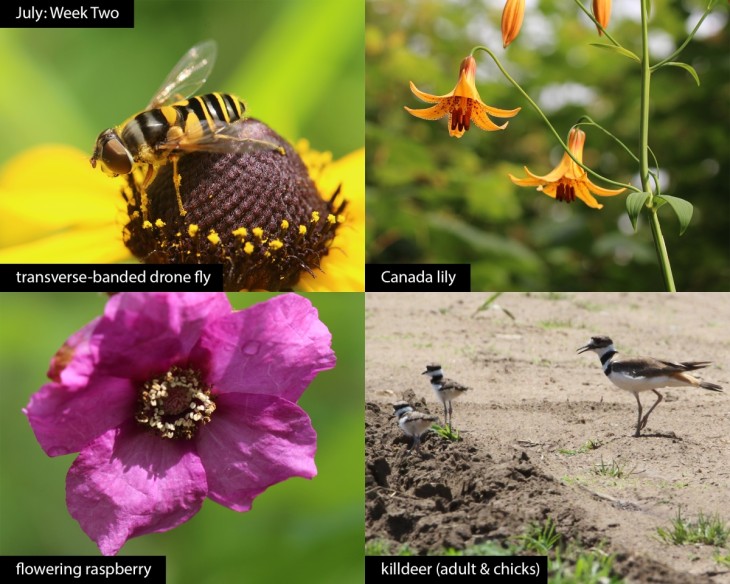This week in the woods, we admired this transverse-banded drone fly accumulating Rudbeckia pollen. This common insect belongs to the family Syrphidae, also known as syrphid flies, flower flies (for their predictable presence around flowers), and hover flies, for their ability to remain stationary in flight. While many hover flies may resemble bees or wasps because of their yellow and black abdomens and overlap in habitat, and they also serve as pollinators, they can be identified as flies for having two wings rather than four, short antennae, eyes at the front of their heads, and no distinct “waist.” As Joe Rankin describes in this Outside Story article, these “bee mimics” benefit from the reputation of stinging insects without themselves having the ability to sting. Among the many hover flies in our area, this species stands out for its yellow scutellum, the shield-shaped structure between the upper parts of its wings.
Around this time, the Canada lily puts out crowns of yellow-to-red flowers with curved, speckled tepals in moist meadows and woodland edges. Its stalks often reach well over six feet, and its lance-shaped leaves grow in whorls. This native doesn’t occur in nearly the abundance as its introduced, unfreckled counterpart, the orange daylily, so enjoy it when you find it (if white-tailed deer don’t get to it first).
Flowering raspberry (or purple-flowered raspberry or Virginia raspberry) also blossoms now in marginal areas and forest openings. Its lavender flowers occur profusely in clusters among distinct maple-like leaves, and unlike other raspberry species, the canes have no thorns. Benjamin Lord has more on how to tell apart wild brambles in this article from our Summer 2017 issue.
Killdeer chicks imprint upon their parents within hours of hatching and are ready to run as soon as their feathers dry. Until these precocial birds can fly (within three or four weeks, relatively fast by avian standards), the chicks scuttle after adults through their open habitats, picking at the ground for their own food. Meghan McCarthy McPhaul gives a full profile of this bird (a shorebird you can see far from the shore) in an Outside Story essay from our archives.
What have you noticed in the woods this week? Submit a recent photo for possible inclusion in our monthly online Reader Photo Gallery.


